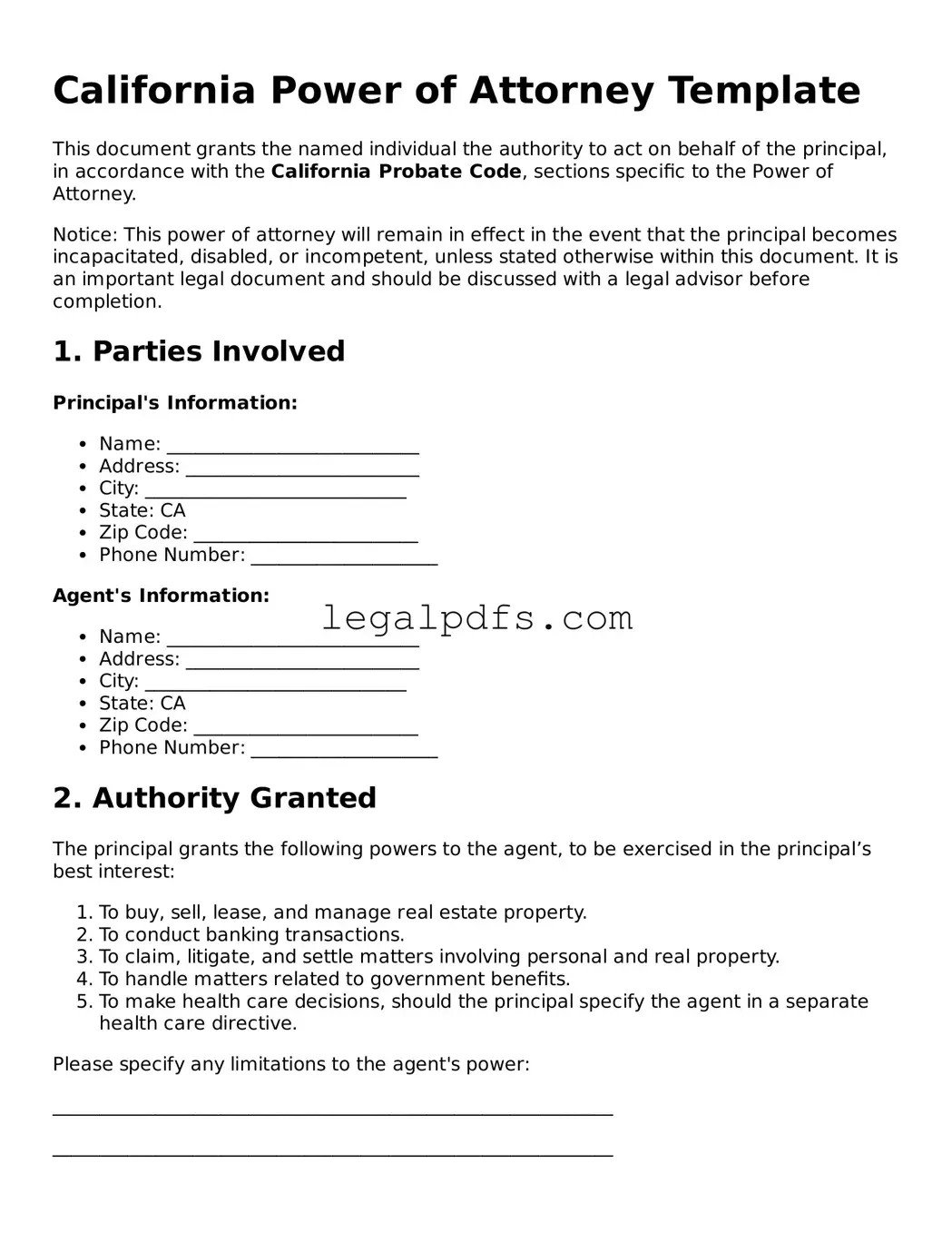California Power of Attorney Template
This document grants the named individual the authority to act on behalf of the principal, in accordance with the California Probate Code, sections specific to the Power of Attorney.
Notice: This power of attorney will remain in effect in the event that the principal becomes incapacitated, disabled, or incompetent, unless stated otherwise within this document. It is an important legal document and should be discussed with a legal advisor before completion.
1. Parties Involved
Principal's Information:
- Name: ___________________________
- Address: _________________________
- City: ____________________________
- State: CA
- Zip Code: ________________________
- Phone Number: ____________________
Agent's Information:
- Name: ___________________________
- Address: _________________________
- City: ____________________________
- State: CA
- Zip Code: ________________________
- Phone Number: ____________________
2. Authority Granted
The principal grants the following powers to the agent, to be exercised in the principal’s best interest:
- To buy, sell, lease, and manage real estate property.
- To conduct banking transactions.
- To claim, litigate, and settle matters involving personal and real property.
- To handle matters related to government benefits.
- To make health care decisions, should the principal specify the agent in a separate health care directive.
Please specify any limitations to the agent's power:
____________________________________________________________
____________________________________________________________
3. Term
This Power of Attorney is effective as of ________ (date) and will continue until it is revoked by the principal or upon the principal’s death, unless a specific termination date is mentioned here: ________________.
4. Third Party Reliance
Third parties may rely upon the representation of the Agent as to all matters relating to any power granted to the Agent, and no person or agency dealing with the Agent will be required to inquire into the authority of the Agent or to see to the application of any funds or property.
5. Revocation
The principal may revoke this power of attorney at any time by providing written notice to the agent. This revocation will be effective immediately upon the agent’s receipt of the notice.
6. Governing Law
This Power of Attorney will be governed by the laws of the state of California, without giving effect to any principles of conflicts of law.
7. Principal's Signature
The principal must sign and date this form.
Date: _____________
Principal’s Signature: _____________________
8. Agent's Acknowledgment
By signing below, the agent acknowledges and agrees to the duties and limitations of authority outlined in this document.
Date: _____________
Agent’s Signature: _____________________
9. Witness or Notarization
This document must be either signed by two witnesses or notarized to ensure its effectiveness. California law requires that witnesses be adults and not named as agents within this document.
Witnesses:
Witness 1 Name: _____________________
Witness 1 Signature: __________________
Date: _____________
Witness 2 Name: _____________________
Witness 2 Signature: __________________
Date: _____________
Or
Notary Public:
State of California
County of ________________________
On _____________, before me, ________________________ (Notary Public), personally appeared ________________________, who proved to me on the basis of satisfactory evidence to be the person(s) whose name(s) is/are subscribed to the within instrument, and acknowledged to me that he/she/they executed the same in his/her/their authorized capacity(ies), and that by his/her/their signature(s) on the instrument the person(s), or the entity upon behalf of which the person(s) acted, executed the instrument.
Notary Signature: _________________________
Commission Expires: ______________________
